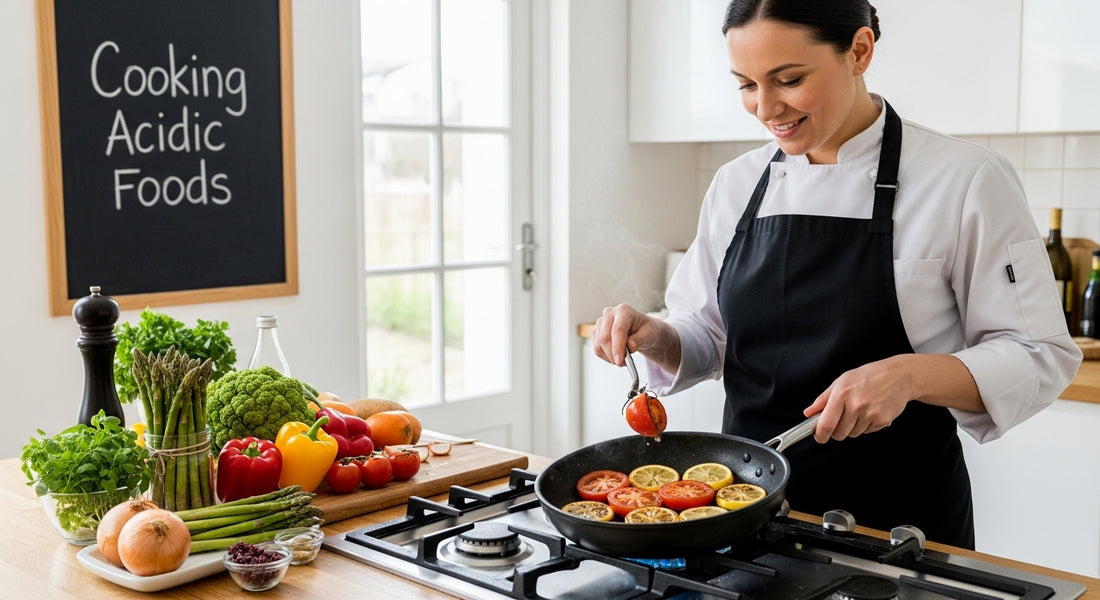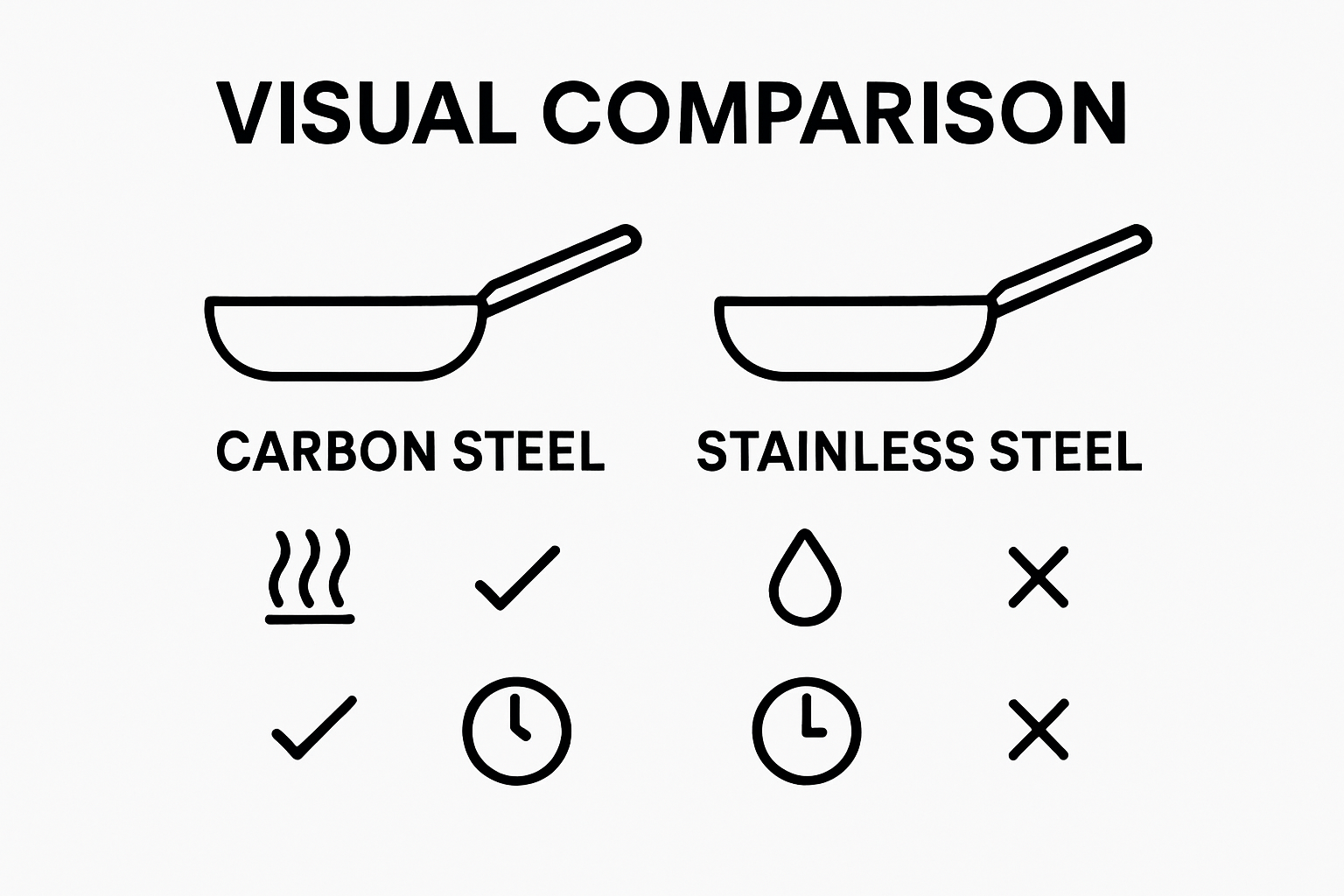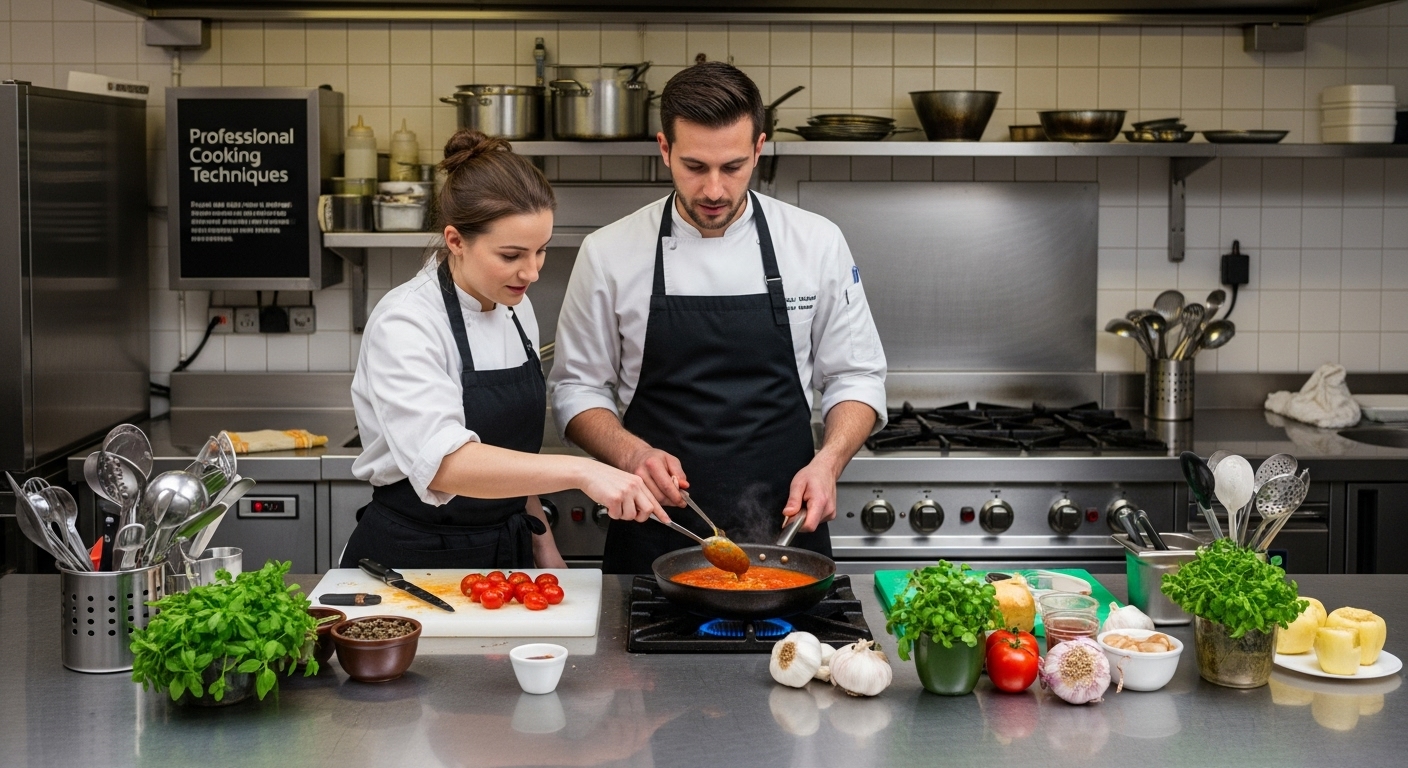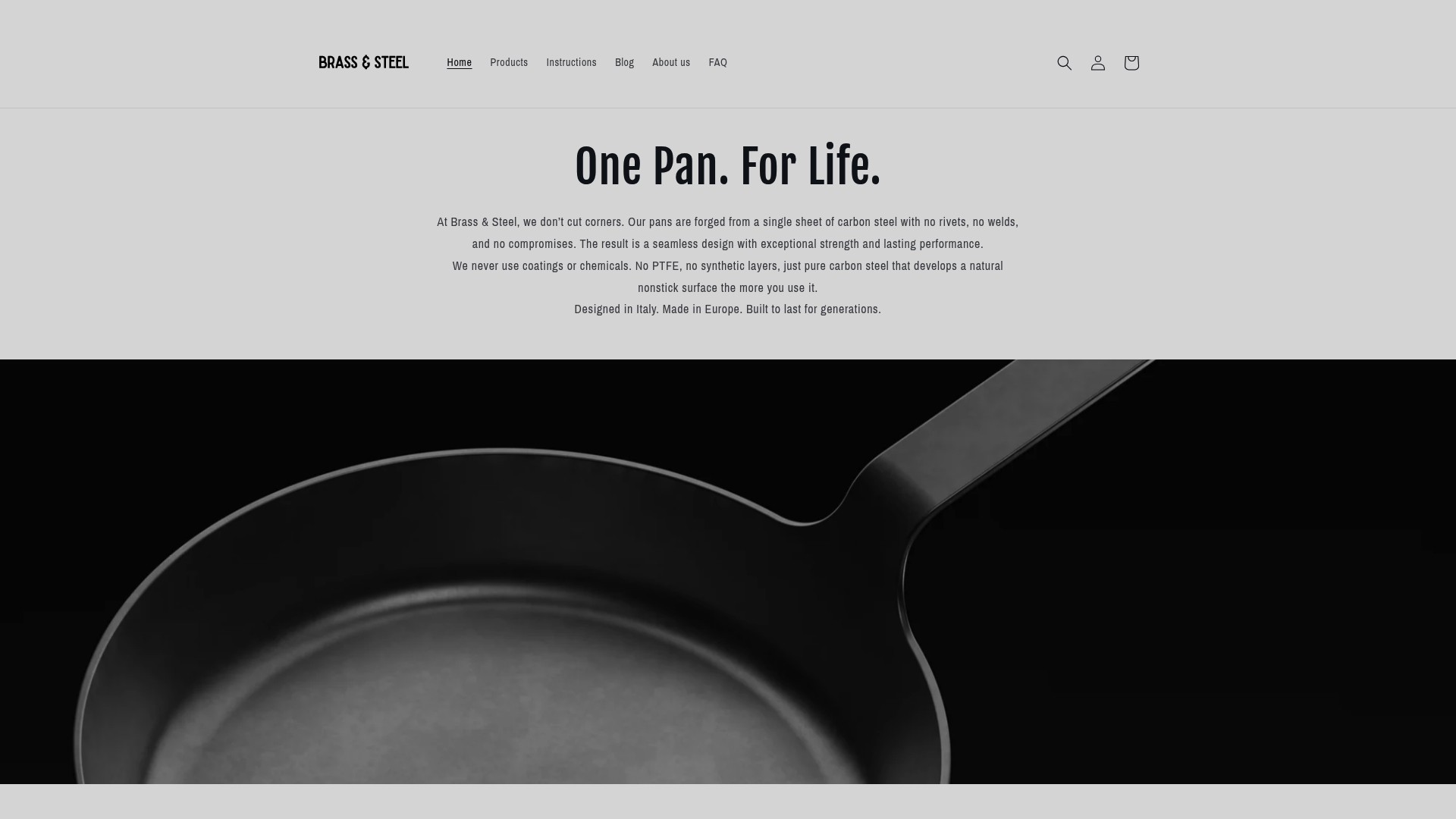
Understanding Cooking Acidic Foods in Carbon Steel
Share
Carbon steel pans hold a special place in kitchens world-wide, admired for their sharp heat response and culinary versatility. Many are shocked to learn that seasoned carbon steel can develop a nonstick surface just like modern coatings, without any chemicals at all. Yet what throws most people off is that cooking something as simple as tomatoes can change everything, leading to unexpected flavours and even affecting your pan’s surface in ways you might not guess.
Table of Contents
- What Is Carbon Steel And How Does It Differ From Other Materials?
- Understanding The Chemical Interactions Of Acidic Foods With Carbon Steel
- Why Cooking Acidic Foods In Carbon Steel Matters For Flavour And Safety
- The Science Behind Seasoning And Maintenance Of Carbon Steel Cookware
- Real-World Applications: Chefs’ Experiences With Acidic Cooking In Carbon Steel
Quick Summary
| Takeaway | Explanation |
|---|---|
| Carbon steel offers superior heat responsiveness | Its composition allows for rapid, even heat distribution, making it ideal for professional cooking. |
| Maintain a strong seasoning layer for protection | A robust seasoning prevents metal contact with acidic foods, enhancing flavour and longevity of the pan. |
| Avoid prolonged contact with acidic ingredients | Limiting cooking time with acidic foods reduces the risk of metal ion transfer that can alter taste. |
| Regularly maintain and re-season your cookware | Proper care ensures the nonstick properties are preserved and enhances the performance of carbon steel pans. |
| Choose cooking oils carefully for seasoning | Selecting appropriate oils during seasoning can improve the cookware’s durability and cooking quality. |
What is Carbon Steel and How Does it Differ from Other Materials?
Carbon steel represents a unique metal alloy with distinct properties that set it apart from other cookware materials. At its core, carbon steel is an iron alloy containing between 0.05% and 2.1% carbon by weight, which significantly influences its performance characteristics. Research from Britannica confirms that the carbon content determines the metal’s hardness, strength, and durability.
The Composition and Structural Characteristics
Unlike stainless steel, which incorporates chromium and nickel for corrosion resistance, carbon steel maintains a simpler composition. Its primary components are iron and carbon, creating a material that is highly responsive to heat and capable of developing a natural nonstick surface through seasoning. The molecular structure allows for rapid and even heat distribution, making it a favourite among professional chefs and cooking enthusiasts.
Key characteristics of carbon steel include:
- Excellent heat conductivity
- Ability to develop a natural seasoning layer
- Lightweight compared to cast iron
- Remarkable durability when properly maintained
Performance Differences in Cookware Materials
When comparing carbon steel to other cookware materials, several critical differences emerge. Cast iron, while similar, is heavier and slower to heat. Stainless steel offers better corrosion resistance but lacks the same heat responsiveness. Comparative research from Materials Science indicates that carbon steel strikes an optimal balance between performance and versatility.
For home cooks interested in understanding whether carbon steel might suit their kitchen, we recommend reading our comprehensive guide on selecting the right cookware. The unique properties of carbon steel make it an exceptional choice for those seeking professional-grade cooking performance with proper care and maintenance.
To help you compare popular cookware materials mentioned in this article, here is a concise breakdown of their core characteristics.
| Material | Main Composition | Heat Response | Weight | Surface Benefits | Corrosion Resistance |
|---|---|---|---|---|---|
| Carbon Steel | Iron + 0.05-2.1% Carbon | Rapid, sensitive | Light | Develops natural nonstick | Requires seasoning |
| Cast Iron | Iron + higher carbon | Slow, retains well | Heavy | Develops seasoning layer | Prone if unseasoned |
| Stainless Steel | Iron + Chromium/Nickel | Responsive, even | Moderate | Smooth, does not season | High (self-protecting) |
| Modern Nonstick | Metal + chemical coating (e.g. PTFE) | Quick, even | Very light | Synthetic nonstick | High unless scratched |

Understanding the Chemical Interactions of Acidic Foods with Carbon Steel
Carbon steel cookware presents unique challenges when preparing acidic foods, as its metallic composition can trigger complex chemical reactions that impact both the cookware and the food being prepared. These interactions are fundamental to understanding how to properly use and maintain carbon steel pans.
This table summarises the main chemical interactions that occur between acidic foods and carbon steel cookware as described in the article.
| Characteristic | Description |
|---|---|
| Accelerated Metal Ion Transfer | Low pH increases leaching of iron ions into food |
| Potential Metallic Taste Development | Iron ions cause metallic flavour notes in food |
| Temporary Breakdown of Seasoning Layer | Acid can disrupt or erode the protective seasoning |
| Increased Risk of Pan Surface Degradation | Prolonged acid exposure accelerates pan wear |
The Science of Metal Reactivity
Acidic ingredients such as tomatoes, citrus fruits, wine, and vinegar have a low pH level that can potentially react with the iron molecules in carbon steel. Research from Materials Science demonstrates that these acidic environments can cause metal ions to leach into food, potentially altering taste and nutritional characteristics.
Key chemical interaction characteristics include:
- Accelerated metal ion transfer at lower pH levels
- Potential metallic taste development
- Temporary breakdown of seasoning layers
- Increased risk of pan surface degradation
Managing Acidic Food Interactions
To minimise unwanted chemical reactions, experienced cooks employ several strategic approaches. Maintaining a robust seasoning layer acts as a protective barrier between the metal surface and acidic ingredients. This seasoning creates a natural nonstick coating that reduces direct metal contact. Limiting prolonged cooking times with highly acidic foods and using well-seasoned pans can significantly mitigate potential negative interactions.
Learn more about maintaining your carbon steel cookware for optimal performance. Understanding these chemical interactions empowers cooks to use carbon steel effectively while preserving both the cookware and the culinary integrity of their dishes.
Why Cooking Acidic Foods in Carbon Steel Matters for Flavour and Safety
Cooking with carbon steel requires nuanced understanding, particularly when preparing dishes containing acidic ingredients. The interaction between acidic foods and carbon steel can profoundly impact both culinary outcomes and cookware performance.
Flavour Dynamics and Metal Ion Transfer
Research from Culinary Science reveals that acidic ingredients like tomatoes, citrus, and vinegar can trigger complex chemical reactions in carbon steel pans. These reactions potentially transfer microscopic iron ions into the food, which can subtly alter taste profiles and nutritional composition.
Key considerations for cooking acidic foods include:
- Potential metallic taste development
- Minor increases in dietary iron content
- Temporary disruption of seasoning layers
- Risk of accelerated pan surface degradation
Safety and Nutritional Implications
Prolonged exposure to acidic environments can compromise the protective seasoning layer of carbon steel cookware. This breakdown increases the likelihood of direct metal contact with food, which might introduce undesirable metallic notes and potentially impact the pan’s long-term durability. Home cooks with specific health conditions, such as hemochromatosis, should exercise additional caution when preparing acidic dishes.
Explore our comprehensive guide comparing cookware materials to understand how different cooking surfaces interact with various ingredients. Understanding these nuanced interactions empowers cooks to make informed decisions about their cookware selection and maintenance strategies.
The Science Behind Seasoning and Maintenance of Carbon Steel Cookware
Seasoning transforms carbon steel from a bare metal surface into a high-performance cooking tool, creating a naturally protective and nonstick layer through a complex molecular process. This intricate chemical transformation is fundamental to understanding carbon steel cookware’s remarkable culinary capabilities.
The Chemical Process of Seasoning
Research from Chemical & Engineering News explains that seasoning occurs through polymerization, where heating oils at high temperatures causes their molecules to break down and recombine, forming a durable molecular bond with the metal surface. This process creates a carbonized layer that prevents rust and provides a smooth cooking surface.
Key seasoning characteristics include:
- Molecular bonding between oil and metal
- Gradual development of nonstick properties
- Enhanced corrosion resistance
- Improved heat distribution
Maintenance and Long-Term Performance
Proper maintenance is crucial for preserving the seasoned surface. Regular cooking with fatty foods, avoiding prolonged exposure to acidic ingredients, and implementing careful cleaning techniques help maintain the protective layer. Extreme temperature changes and harsh scrubbing can damage the seasoning, requiring careful attention and periodic re-seasoning.
Learn our detailed step-by-step guide to seasoning your carbon steel pan to ensure optimal cookware performance and longevity. Understanding the science behind seasoning empowers cooks to transform their carbon steel cookware into a cherished kitchen tool that improves with every use.
Real-World Applications: Chefs’ Experiences with Acidic Cooking in Carbon Steel
Professional chefs have developed sophisticated strategies for navigating the delicate relationship between carbon steel cookware and acidic ingredients, transforming potential challenges into culinary opportunities.
Professional Cooking Techniques
Research from Food Science Studies highlights how experienced chefs manage mineral migration and flavour interactions when cooking acidic dishes in carbon steel. Professional kitchens prioritize strategic cooking methods that minimise potential negative interactions while maximising the unique heat conductivity of carbon steel.
Key chef considerations include:
- Minimising prolonged acidic food contact
- Using well-seasoned pans with robust protective layers
- Monitoring cooking times and temperatures
- Selecting appropriate oils for seasoning
Culinary Performance and Adaptations
Chefs recognise that carbon steel requires nuanced handling, particularly with ingredients like tomato sauces, wine reductions, and citrus-based preparations. Rapid cooking techniques and precise temperature control become critical in preventing excessive metal ion transfer and maintaining the integrity of both the cookware and the dish.
Explore our comprehensive guide on maintaining carbon steel cookware to understand the intricate balance between culinary technique and cookware preservation. Understanding these professional insights empowers home cooks to approach carbon steel cooking with confidence and skill.

Unlock the True Potential of Carbon Steel with Acidic Dishes
Struggling to achieve perfect results when cooking acidic foods like tomatoes or citrus in your carbon steel pan? Many passionate cooks share your concerns about protecting pan seasoning, avoiding metallic tastes, and ensuring long-lasting durability. At Brass & Steel, we understand how important it is to balance flavour, care, and the life of your cookware when using carbon steel with challenging ingredients. Our Carbon Steel Collection was created for cooks who want confidence with every meal — including those delicate sauces and vibrant reductions mentioned in our article.

Do not let your cookware limit your creativity in the kitchen. Choose a naturally nonstick, PTFE-free, and induction ready carbon steel pan designed to resist the stress of acidic cooking. Explore more at Brass & Steel and upgrade to a pan that stands up to every recipe and every challenge. Browse our full collection of heirloom-quality carbon steel pans and experience seamless performance you can trust. Your next meal deserves nothing less.
Frequently Asked Questions
What is the impact of cooking acidic foods in carbon steel cookware?
Cooking acidic foods such as tomatoes, citrus, and vinegar in carbon steel can trigger chemical reactions that may affect both the flavour of the food and the seasoning layer of the cookware. Prolonged contact with acidic ingredients can lead to a metallic taste and potential degradation of the pan’s surface.
How can I minimise the effects of acidic foods on carbon steel?
To minimise the impact, ensure your carbon steel pan is well-seasoned, as this creates a protective barrier. Limit the cooking time of acidic foods and avoid using harsh scrubbing methods that could damage the seasoning layer.
Is it safe to cook with acidic ingredients in carbon steel?
While it is safe to cook with acidic ingredients in carbon steel, caution is advised. Prolonged exposure can lead to direct contact between food and metal, which may affect taste and safety. Cooks with specific health conditions, like hemochromatosis, should take additional care.
What are the benefits of using carbon steel cookware compared to other materials?
Carbon steel offers excellent heat conductivity and responsiveness, making it a versatile option for various cooking techniques. Unlike stainless steel, it develops a natural nonstick surface through seasoning, and it is lighter than cast iron, providing ease of handling while retaining durability.